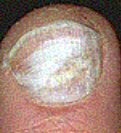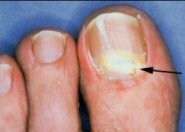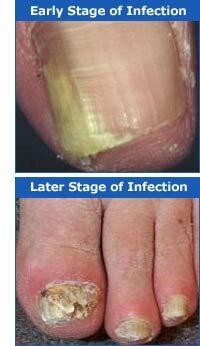Nail Fungus (Onychomycosis)
Description
Nail Fungus (Onychomycosis) is a progressive disease of the toenails and fingernails. Nail fungus is the most common cause of discolored, thick, and deformed toenails. Not all discolored and thickened nails are fungus infections. There are other conditions that will cause the nails to have a similar appearance i.e. psoriatic nail disease, dystrophic nails as maybe present in patients with compromised circulation. Toenails are affected more often than fingernails because the fungi that cause this disease thrive in the dark, warm, moist environment that is found in our shoes. Infected nails may first appear as a yellowish, white, or green discoloration of a small area of the toenail. If left untreated, the entire nail may eventually become discolored, thick, flaky, detached from the underlying nail bed; and an accumulation of dead, white, dry material may form between the nail and underlying nail bed. The infected toenails are usually not painful until the nail becomes so thick that it rubs against the toe box of the shoe.
What is a Fungus? Fungi (plural) belong to a group of primitive organisms that includes mushrooms, yeasts, rusts, and molds. The most common species of fungi that attacks the skin and nails of humans fall within the category known asdermatophytes. Dermatophytes are the parasitic fungi that attack and cause diseases of the skin and nails.
Function of the Toenails: Toenails once served as claws and aided early humans in defending themselves, and allowing them to climb and move over certain ground surfaces more easily. Today they serve to protect the underlying tissue and bone, and when they cause chronic problems, the nails can be removed without inconveniencing the individual. With that being said, having ten toenails and fingernails is certainly more cosmetically pleasing than missing a nail here or there! The anatomy of the nail is divided into six specific parts:
|
|
Rate of Nail Growth: Nails grow from the day we are born until we die. The rate at which nails grow becomes slower as we age; certain diseases, poor circulation, dietary deficiencies, some medications, and chemotherapy can also affect growth rate. Fingernails grow faster than toenails, at a rate of 3mm per month. It takes 6 months for a fingernail to grow from the root to the free edge. Toenails grow about 1 mm per month, and take about 12 months to be completely replaced.
Symptoms & Diagnosis
The symptoms of nail fungus can vary greatly according to the:
-
Type of nail fungus infection present.
-
Duration of the infection. The early signs are much different from those that are seen after the infection has been present for some time. Usually, there is no pain until the latter stages of the disease when the nail plate becomes thick and deformed.



Causes
How a Fungal Nail Infection Occurs: In order for a fungal infection of the nail to occur, the fungus must successfully attack and penetrate the nail plate or nail bed. This can only happen if the nail plate is damaged or separated from the underlying nail bed. This damage or separation needs only be microscopic in size; that is all a fungus needs to invade the nail. Most healthy people have a natural immunity to these organisms, so they can successfully destroy the fungi before it takes hold in the nail plate or bed. Those who do not have this immunity are among the millions of Americans who suffer from onychomycosis (fungal nail infections).
Predisposing Factors (or those factors which increases a person’s chances of developing a fungal nail infection):
-
Certain systemic diseases decrease the efficiency of the immune system making it difficult to fight off nail fungi:
-
Poor circulation
-
Diabetes
-
Immunosuppressive diseases
-
Cancer that is being treated with radiation or chemotherapy
-
-
Improperly cleaned and sterilized pedicure instruments and soaking tubs makes it easy for fungi to be transferred from one person’s infected nail to someone else’s healthy/normal nail. “An ounce of prevention is worth a pound of cure” is most appropriate when visiting a nail salon: Bring your own professional quality pedicure/manicure instruments and tub liners with you! Find out more about these safe and affordable instruments.
-
Toenail fungus may spread from foot to foot on the wet floors of showers and locker rooms, and around swimming pools. Those who frequently use these facilities can be at greater risk for fungal nail infections.
-
The fungi that cause athlete’s foot of the skin are the same organisms that cause fungal nail infections. Therefore, those people who experience frequent attacks of athlete’s foot are more prone to developing fungal nail infections.
-
Fungi need moisture to survive. People, who have sweaty feet, or those who practice poor foot hygiene, are more susceptible to fungal nail infections.
-
Frequent injuries to the toenails may loosen the nail from the nail bed, allowing fungi to invade the nail. Athletes, and those who wear tight or pointed toe shoes frequently injure their toenails, thus increasing their risk of fungus toenails.
-
Constantly wearing nail polish prevents the air from getting to the nail plate. Fresh air helps to keep nails dry and healthy. Also, the harsh chemicals in the nail polish may help to destroy the normal structure of the nail. This can make it easier for a fungus to invade and penetrate the nail. However, Dr. Remedy’s Natural Nail Polish colors the nails beautifully without dangerous chemicals and protects nails from fungal disease.
Treatments
The sooner treatment is begun, the faster the nail will return to normal. Topical medications, or those applied directly to the nail, are most effective when the infection has not:
-
Grown under the proximal nail fold (click here for information about The Anatomy of the Nail)
-
Produced a thick and deformed toenail
If the infection has spread under the proximal nail fold or produced a thick and deformed nail, you may want to discuss using Oral anti-fungal medications with your doctor. Oral medications may produce some serious side effects, and it is for this reason that your doctor may insist that you try Topical medicationsfirst. Treatment of fungal nail infections can be very frustrating, especially if you are using the wrong product! You can save time and money by using these products - the products that doctors recommend. We have found that the following Topical Medications are uniquely effective in the treatment of fungal nail infections:
-
Dr. Smith’s Toenail Fungus Treatment
-
Dr.’s Remedy Enriched Nail Polishes
-
NonyX Nail Gel
-
Pedinol Fungoid Tincture
The thinner the nail plate, the easier it is for topical antifungal medications to produce positive effects. If your nails are thick and deformed, filing the nail thinner can reduce treatment time and the discomfort produced by thick nails. The PediNova III Electric Nail and Foot Care Instrument is a high performance medical grade instrument that easily thins hard, deformed, and thick nails.
The use of an ultra violet shoe sanitizer is an excellent source for containing further fungus involvement during treatment. Even after successful treatment fungus growth already established in the shoes may re-infect the nails beginning the cycle over again.
Currently Laser treatment has become the treatment choice for advanced and long-standing cases that has not responded to topical and or oral medications. The use of Laser for treating nail fungus has shown to be an effective modality but as in all treatments for fungus nails, it is not permanent and infection can reoccur.
